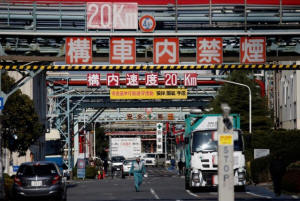|
Asian factories end robust 2017 on mixed
note; central banks seen hiking slowly
 Send a link to a friend
Send a link to a friend
 [January 02, 2018]
By Marius Zaharia [January 02, 2018]
By Marius Zaharia
HONG KONG (Reuters) - Asia's factories
ended a strong 2017 on a mixed note, with activity at multi-year highs
in Taiwan and India and surprisingly picking up in China, but
contracting in some places in a sign regional interest rate hikes likely
will be gradual.
A trend of synchronised global growth that became apparent over the
course of last year looked set to continue, with activity surveys in the
euro zone and the United States later in the day expected to post strong
readings.
"Robust external demand and accommodative domestic monetary policy
should help keep Asian manufacturing sectors in good shape," said
Krystal Tan, Asia economist at Capital Economics.
In China, manufacturing growth unexpectedly picked up to a four-month
high in December amid a surge in new orders, suggesting continued
strength in global trade.

The Caixin/Markit Manufacturing Purchasing Managers' Index (PMI) rose to
51.5 last month, from 50.8 in November, and far outpaced economists'
expectations for a dip to 50.6. The 50-mark divides expansion from
contraction on a monthly basis.
Tuesday's survey, which pushed Asian shares <.MIAPJ0000PUS> to their
highest in a decade, was somewhat at odds with a much larger official
China PMI survey on Sunday. It showed a slowdown in growth amid a
crackdown on pollution and measures to curb risky financing and cool the
housing market.
Analysts say the difference stems from the fact that the Caixin/PMI
index tracks smaller, private firms, more sensitive to exports.
A CHINA SLOWDOWN?
China is expected to have grown by close to 7 percent in 2017, but the
world's second largest economy is likely to slow in the new year on the
back of those measures, highlighted as policy priorities at October's
key Communist Party congress.
Beijing is expected to target 2018 growth at around 6.5 percent.
"We believe a moderate growth slowdown to be more visible in the first
half of 2018, especially on the investment front, due mainly to the
tight financial conditions and a cooldown of the property market," BofA
Merrill Lynch economists said.
China's slowdown means that for the rest of Asia, the pace of rate
increases is unlikely to match that of the U.S. Federal Reserve, which
is seen hiking 2-3 times in 2018.
There will likely be "only a few rate hikes here and there across the
region over the coming two years," HSBC analysts said in a note, even as
they expect Asian economies to keep chugging along in 2018, led by tech
and trade.
[to top of second column]
|

Workers walk at a factory at the Keihin industrial zone in Kawasaki,
Japan February 28, 2017. REUTERS/Issei Kato/File Photo

In November, the Bank of Korea raised interest rates for the first
time in more than six years, becoming the first major Asian central
bank to hike since 2014. Malaysia and the Philippines could hike
early this year, then Australia and New Zealand later on.
RIDING A TECH BOOM
On Sunday, South Korea's central bank chief said monetary policy
should remain accommodative as inflationary pressures remained weak.
Factory activity, which has been riding a global tech boom,
contracted in December, dropping from a 4-1/2 year high in November,
the Nikkei/Markit survey showed.
Another major tech producer, Taiwan, saw manufacturing activity
hitting its highest since April 2011 at 56.6 last month, according
to a December survey.
Singapore on Tuesday posted slower economic growth in the fourth
quarter than the third as manufacturing shrank 11.5 percent
following an eye-popping 38 percent jump in the previous three
months.
However, full-year growth was still the fastest in three years at
3.5 percent, raising the possibility that the Monetary Authority of
Singapore (MAS) could tighten its exchange rate-based monetary
policy this year.
"Given robust GDP growth and inflation upside risk, we think MAS
will shift and tighten to a 'mild appreciation bias' at the April
meeting," Maybank Kim Eng economist Chua Hak Bin said.
PMIs for Japan, which surpassed growth expectations in 2017 on the
back of the surging tech and trade cycle globally, will be released
on Thursday.

The Nikkei/Markit survey for India's December factory activity
showed it expanded at the fastest pace in five years, buoyed by a
rise in output and new orders, which allowed firms to raise prices.
The data firms up views that interest rates in Asia's third-largest
economy have probably bottomed.
December factory activity accelerated in Vietnam, but shrank
marginally in Malaysia and Indonesia.
(Reporting by Marius Zaharia; Editing by Richard Borsuk)
[© 2018 Thomson Reuters. All rights
reserved.]
Copyright 2018 Reuters. All rights reserved. This material may not be published,
broadcast, rewritten or redistributed. |